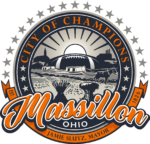The City of Massillon’s Storm Water Management Program in conjunction with the Clean Water Act serves to radically reduce or eliminate pollutants from entering the MS4 or Municipal Separate Storm Sewer System. Through activities known as best management practices or BMP’s, the City conducts municipal maintenance (e.g., street sweeping and catch basin cleaning), public education and outreach, new development and construction controls, illicit discharge control activities, monitoring and special studies, and watershed management activities, in conjunction with the Stark Soil and Water Conservation District.
REPORTING A PROBLEM:
- To report an emergency situation such as a hazardous waste spill or situation that will result in the imminent and substantial danger to the health and safety of persons please call 911.
- To report illegal dumping in the Tuscarawas River, Sippo Creek, Little Sippo Creek, Newman Creek, Wetmore Creek, the Brookfield Ditch or an illicit discharge into the City’s storm sewer drainage system please call the City of Massillon Engineering Department at (330) 830-1722 or The Stark Soil & Water Conservation District at (330)-830-7700.
An Illicit Discharge is any discharge to an MS4 that is not composed entirely of storm water, except those discharges to the MS4 pursuant to a NPDES Permit or noted in current ordinance 53-2008-ILLICIT DISCHARGE AND ILLEGAL CONNECTION CONTROL.
Clean Water Act
Introduction
The Clean Water Act (CWA) is mandated under the 1987 Amendments to the Federal Water Pollution Control Act. It is the cornerstone of surface water quality protection in the United States. (The Act does not deal directly with ground water nor with water quantity issues.) The statute employs a variety of regulatory and non regulatory tools to sharply reduce direct pollutant discharges into waterways, finance municipal wastewater treatment facilities, and manage polluted runoff. These tools are employed to achieve the broader goal of restoring and maintaining the chemical, physical, and biological integrity of the nation’s waters so that they can support “the protection and propagation of fish, shellfish, and wildlife and recreation in and on the water.”
During the last decade more attention has been given to physical and biological integrity. Also, in the early decades of the Act’s implementation, efforts focused on regulating discharges from traditional “point source” facilities, such as municipal sewage plants and industrial facilities, with little attention paid to runoff from streets, construction sites, farms, and other “wet-weather” sources.
Starting in the late 1980s, efforts to address polluted runoff have increased significantly. For “non point” runoff, voluntary programs, including cost-sharing with landowners are the key tool. For “wet weather point sources” like urban storm sewer systems and construction sites, a regulatory approach is being employed.
Evolution of CWA programs over the last decade have also included something of a shift from a program-by-program, source-by-source, pollutant-by-pollutant approach to more holistic watershed-based strategies. Under the watershed approach equal emphasis is placed on protecting healthy waters and restoring impaired ones.
A full array of issues are addressed, not just those subject to CWA regulatory authority. Involvement of stakeholder groups in the development and implementation of strategies for achieving and maintaining state water quality and other environmental goals is another hallmark of this approach.
NPDES
Brief History of NPDES Program
The National Pollutant Discharge Elimination System (NPDES) originally began as part of the 1972 Clean Water Act. The U.S. Environmental Protection Agency (USEPA) initially targeted point-source pollution (industrial plants, sewage plants) with sampling, monitoring, water treatment, improved material handling, better manufacturing technology, etc. This portion of the NPDES program has been very effective at improving water quality for lakes and streams in urban areas. However, as more data was gathered, it was learned that most pollution comes from non point sources where it is difficult to identify the source and responsible party. Non point pollution sources include:soil erosion, aerially-deposited particles, roadside trash, leaves and sticks, automotive fluids from leaking vehicles, products of incomplete combustion, food processing wastes, and transportation spills of chemicals and other pollutants.
The Clean Water Act was amended in 1987 to include provisions for reducing non point pollution sources. The NPDES permit system is managed by the Ohio Environmental Protection Agency with federal oversight maintained by USEPA.
The Storm Water Phase II Regulation requires that large and medium-sized cities/counties must obtain a NPDES permit for municipal separate storm sewer systems (MS4s). These NPDES permits are renewable for a period of 5 years. A storm water management program must be developed to reduce storm water pollution, with several elements for which demonstrable progress must be achieved each year.
Planning
City of Massillon Storm Water Utility Ordinance
Storm water District Review and Appeals Board 943.07
The Stark Soil & Water Conservation District
Stark SWCD
2800 Richville Drive SE Suite 100
Massillon, OH 44646
330-451-7645
Education
City of Massillon Storm Water News
July 2019
March 2020
February 2021
March 2022
May 2023
March 2024
Ohio Maintaining Storm Water Control Measures
City of Massillon Builder Brochure
Storm water Detention Pond Guidelines for Homeowners
Detention/Retention Pond Locations
Property Owner (HOA) Required Maintenance
Augusta Lakes
Kenyon Creek
Country View Meadows
Tennyson NE
Centennial Village
University Village
Castlewest Estates
Orchard Hill
Millcreek Run
Danbury
Gray Ridge
Autumn Ridge
Parkview Estates
Sippo Reserves
VillaSole
Friendship Acres/Westbrook Estates
Basin A
Basin B C D
Basin E F G
Basin H
